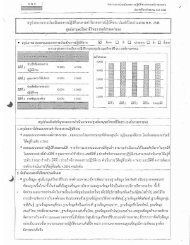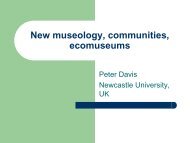Download
Download
Download
You also want an ePaper? Increase the reach of your titles
YUMPU automatically turns print PDFs into web optimized ePapers that Google loves.
were among tens of thousands of Lao, Phuan, Saek,Kaloeng, and Bru peoples who were relocated in Siam’sattempt to empty towns and cities on the western sideof the Mekong to permanently destroy the Lao Kingdomand cut off supply lines to Vietnam, Siam’s main rival atthe time. Groups of Phu Tai were settled in what are todayMukdahan, Nakhon Phanom, Sakon Nakhon, Kalasin, andUdon Thani provinces. Despite their active political rolein the Free Thai Movement and the Communist Party ofThailand (CPT) during and after World War II (Piyamas2002), the Phu Tai were generally perceived as a “good”and non-threatening ethnic group in post-Cold WarThailand. They have become known in the wider Thaisociety as the Wiang Ping of the Isan region for theirexotic culture and beautiful women. Phu Tai silk textiles,pha prae wa (brocaded silk scarves), produced underQueen Sirikit’s Arts and Crafts Project, are known as “thequeen of silk textiles” and have become a highly prizedcommodity.The Absence of Cultural RightsCultural rights, according to the literature, generallyrefer to special rights for ethnic, religious, and cultural minoritygroups within the state, which support the recognition oftheir cultural practices and the preservation of their culturalheritages and group identities. Historically, the modernThai state has placed great emphasis on integratingpeoples of diverse cultural heritages into the unified Thaicitizenry. National language and education policies havelargely played an assimilating role while the media andthe construction of national historical narratives havecontributed to the homogenization of Thai national identity.I went to Ban Phu with this understanding ofcultural rights in mind, and started exploring how Phu Taivillagers felt about being a member of an ethnic minoritygroup in Thailand, and to see whether the Phu Tai wereasserting any forms of cultural rights claims. I found itdifficult to start a conversation about cultural rights inthe Phu Tai in the village. First of all, the cultural rightsconcept is new in Thailand and it is difficult to explain tothe villagers what it constitutes. Second, when I askedhow they feel about the marginalization of ethnic identitiesby state policies, my Phu Tai respondents were perplexedby the question and found it irrelevant for their own case.“We are proud to be Thai, we are Phu Tai, not chon klumnoi (minorities)” is the reply I often received. My studywas then diverted to formulating an explanation for theabsence of cultural rights consciousness among the PhuTai in Ban Phu and to understanding the relationship thePhu Tai have with their ethnic identity. I found that decadesof state rural development policies and the prevalentlocalism discourse had significantly shaped the way thePhu Tai in Ban Phu relate to their ethnic identity and theirunderstanding of citizenship today.A Development-oriented Village andthe Legacy of the Cold WarDuring my fieldwork, I was struck by thedevelopmentalism narrative that dominated the villagers’self-representation. Villagers often recounted stories fromback in the 1960s and 1970s of how Ban Phu villagersfought to acquire electricity, a high school, and pavedroads. I heard stories about the formation of village youthgroups to promote village development and the concretebenefits that the villagers derived from their connectionswith high ranking military officials and the palace. Themost recited story was that of Ban Phu villagers’ audiencewith the King and Queen of Thailand at Chitlada Palace in1974, facilitated by General Saiyud Kerdphol, the directorof the Communist Suppression Operations Command.During the meeting with the monarch, Ban Phu villagersasked for a high school to be built in their village and itwas granted. In 1975, the military celebrated the openingof the school with a parachute show.During the Cold War in 1950s to 1970s, becauseof its location in the Communist Party of Thailand(CPT)’s area of influence, Ban Phu was subject to Thai







